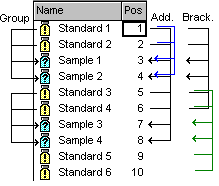Location:
General tab page
Report Variable (Peak Calibration)
Type:
Character
Dimension:
No unit
Value Range:
Fixed/Total/Group/Additional/Bracketed/Standard Addition
Default:
Total
Related Parameter:
Description:
The Calibration Mode parameter determines the standards that are used for calibrating a specific sample of a sequence. Chromeleon provides six different calibration modes.
Select the mode on the General tab page in the QNT Editor (see The QNT Editor ![]() The General Tab Page).
The General Tab Page).
Function:
Fixed
This setting enables the calibration using various standards (also from other sequences).
The desired standards are entered via the Insert Standard or Append Standard commands on the Calibration tab page of the QNT Editor. The sequence the standards are taken from is included in the Sequence column.
If desired, you can enter individual calibration coefficients via the c0, c1, c2, and c3 columns in the amount table.
![]() Tip:
Tip:
Always perform the calibration manually (Calibrate). The Auto-Recalibrate option is not available.
Total
Calibration is performed using all valid standard samples of a sequence. The standard samples disabled in the Enabled column of the Calibration tab page (QNT Editor) are not included.
Group
The calibration of a sample series from the sample list (for example, samples 3 to 50) is performed based on the standard samples listed directly before this series; for example, no. 1 and 2. If this sample list includes additional standards (for instance, no. 51 and 52), the samples that follow (for instance, 53 to 100), will be evaluated based on these. The standard samples in lines 1 and 2 will no longer be considered. (For an example, see the picture below.)
Additional
For calibrating a sample, all standard samples that are listed before this sample in the sample list are used. The further down the sample is listed in the table, the more standard samples will be considered. For an example, see the picture below.
Bracketed
Samples are evaluated based on all standard samples immediately surrounding. In case of a list containing two samples, two standards, two samples, two standards, and so on, samples 1 and 2, located at positions 3 and 4, are evaluated with standards 1, 2, 3, and 4, located at positions 1, 2, 5, and 6. Samples 3 and 4 are evaluated using standards 3, 4, 5, and 6, located at positions 5, 6, 9, and 10. For an example, see the picture below
.
Standard Addition
Use this mode to analyze unspiked samples using the Standard Addition method. In this case, only the sample types Unspiked and Spiked are considered for the analysis. (For more information about these sample types, refer to Spiked Sample).
If several unspiked samples (sample type: Unspiked) are available, only the associated spiked samples are analyzed. Make sure that they are assigned to the same Std. Add Group (Standard Addition Group), i.e., verify that the names indicated in the Standard Addition Group column in the sample list are identical.